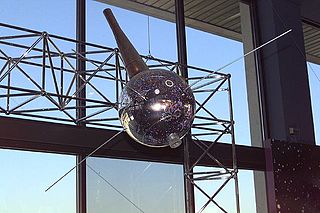
Vanguard 3 is a scientific satellite that was launched into Earth orbit by the Vanguard SLV-7 on 18 September 1959, the third successful Vanguard launch out of eleven attempts. Vanguard rocket: Vanguard Satellite Launch Vehicle-7 (SLV-7) was an unused Vanguard TV-4BU rocket, updated to the final production Satellite Launch Vehicle (SLV).
Explorer 2 was an American unmanned space mission within the Explorer program. Intended to be a repetition of the previous Explorer 1 mission, which placed a satellite into medium Earth orbit, the spacecraft was unable to reach orbit due to a failure in the launch vehicle during launch.

Explorer 35,, was a spin-stabilized spacecraft built by NASA as part of the Explorer program. Designed for the study of the interplanetary plasma, magnetic field, energetic particles, and solar X-rays, from lunar orbit.
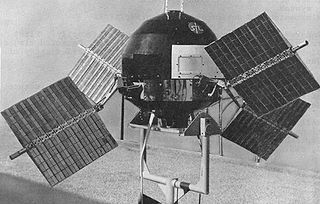
Explorer 6, or S-2, was a NASA satellite, launched on 7 August 1959, at 14:24:20 GMT. It was a small, spheroidal satellite designed to study trapped radiation of various energies, galactic cosmic rays, geomagnetism, radio propagation in the upper atmosphere, and the flux of micrometeorites. It also tested a scanning device designed for photographing the Earth's cloud cover. On 14 August 1959, Explorer 6 took the first photos of Earth from a satellite.
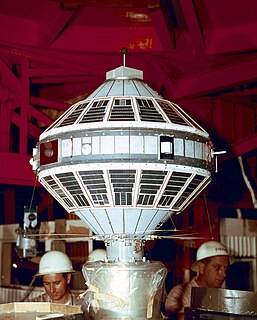
Explorer 7 was a NASA satellite launched on 13 October 1959, at 15:30:04 GMT, by a Juno II launch vehicle from Cape Canaveral Air Force Station (CCAFS) to an orbit of 573 × 1,073 km (356 × 667 mi) and inclination of 50.27°. It was designed to measure solar X-ray and Lyman-alpha flux, trapped energetic particles, and heavy primary cosmic rays. Secondary objectives included collecting data on micrometeoroid penetration, molecular sputtering and studying the Earth-atmosphere heat balance.

The Solar Anomalous and Magnetospheric Particle Explorer was a NASA solar and magnetospheric observatory, and was the first spacecraft in the Small Explorer program. It was launched into low Earth orbit on 3 July 1992, from Vandenberg Air Force Base aboard a Scout G-1 launch vehicle. SAMPEX was an international collaboration between NASA and the Max Planck Institute for Extraterrestrial Physics of Germany. The Solar Anomalous and Magnetospheric Particle Explorer (SAMPEX) is the first of a series of spacecraft that was launched under the Small Explorer (SMEX) mission of program for low cost spacecraft.
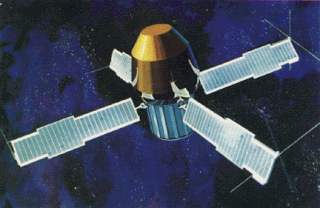
The Small Astronomy Satellite 2, also known also as SAS-2, SAS B or Explorer 48, was a NASA gamma ray telescope. It was launched on 15 November 1972 into the low Earth orbit with a periapsis of 443 km and an apoapsis of 632 km. It completed its observations on 8 June 1973.

Explorer 14, also called EPE-B or Energetic Particles Explorer-B, was a NASA spacecraft instrumented to measure cosmic-ray particles, trapped particles, solar wind protons, and magnetospheric and interplanetary magnetic fields. It was the second of the S-3 series of spacecraft, which also included Explorer 12, 14, 15, and 26. It was launched on 2 October 1962, aboard a Thor-Delta launch vehicle.

Explorer 12, also called EPE-A or Energetic Particles Explorer-A and as S3), was a NASA satellite built to measure the solar wind, cosmic rays, and the Earth's magnetic field. It was the first of the S-3 series of spacecraft, which also included Explorer 12, 14, 15, and 26. It was launched on 16 August 1961, aboard a Thor-Delta launch vehicle. It ceased transmitting on 6 December 1961 due to power failure.

Explorer 28, also called IMP-C, IMP-3 and Interplanetary Monitoring Platform-3, was a NASA satellite launched on 29 May 1965 to study space physics, and was the third spacecraft launched in the Interplanetary Monitoring Platform program. It was powered by chemical batteries and solar panels. There were 7 experiments on board, all devoted to particle studies. Performance was normal until late April 1967, when intermittent problems began. It stayed in contact until 12 May 1967, when contact was lost. The orbit decayed until it re-entered the atmosphere on 4 July 1968. The spacecraft design was similar to its predecessors Explorer 18 (IMP-A), launched in November 1963, and Explorer 21 (IMP-B), launched in October 1964, though this satellite was a few kilograms lighter. The successor Explorer 33 (IMP-D) began the use of a new design.

Explorer S-46 was a NASA satellite with a mass of 41 kg (90 lb). It was the last of the original series of Explorer satellites built, designed, and operated by the Jet Propulsion Laboratory and Army Ballistic Missile Agency (ABMA).
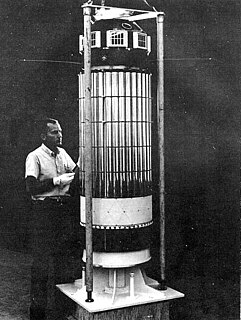
Explorer S-55 was an American satellite launched by NASA on 30 June 1961, as part of the Explorer program. Explorer S-55, was launched using a Scout X-1 launch vehicle from the Wallops Flight Facility (WFF). Its mission was to evaluate the launch vehicle, and investigate micrometeoroid impact and penetration. The mission failed because the third stage failed to ignite and the spacecraft did not achieve orbit.

Explorer 13,, was a NASA satellite launched as part of the Explorer program on 25 August 1961, at 18:29:44 GMT, from Wallops Flight Facility (WFF), Virginia.

Explorer 16, also called S-55B, was a NASA satellite launched as part of the Explorer program. Explorer 16 was launched on 19 December 1962, at 14:33:04 GMT, from Wallops Flight Facility, Virginia, with a Scout X-3.
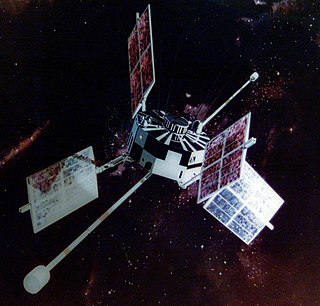
Explorer 34, was a NASA satellite launched as part of Explorer program. Explorer 34 as launched on 24 May 1967 from Vandenberg Air Force Base, California, with Thor-Delta E1 launch vehicle. Explorer 34 was the fifth satellite launched as part of the Interplanetary Monitoring Platform program, but was known as "IMP-4" because the preceding launch was more specifically part of the "Anchored IMP" sub-program. The spacecraft was put into space between the launches of Explorer 33 in 1966 and Explorer 35 in July 1967, but the next satellite to use Explorer 34's general design was Explorer 41, which flew in 1969.

Explorer 41, also called as IMP-G and IMP-5, was a NASA satellite launched as part of Explorer program. Explorer 41 as launched on 21 June 1969 on Vandenberg AFB, California, with a Thor-Delta E1 launch vehicle. Explorer 41 was the seventh satellite launched as part of the overall Interplanetary Monitoring Platform series, though it received the post-launch designation "IMP-5" because two previous flights had used the "AIMP" designation instead. It was preceded by the second of those flights, Explorer 35, launched in July 1967. Its predecessor in the strict IMP series of launches was Explorer 34, launched in May 1967, which shared a similar design to Explorer 41. The next launch was of an IMP satellite was Explorer 43 in 1971.

Explorer 43, also called as IMP-I and IMP-6, was a NASA satellite launched as part of Explorer program. Explorer 43 was launched on 13 March 1971 from Cape Canaveral Air Force Station (CCAFS), with a Thor-Delta M6 launch vehicle. Explorer 43 was the sixth satellite of the Interplanetary Monitoring Platform.

Explorer 45 was a NASA satellite launched as part of Explorer program. Explorer 45 was the only one to be released from the program Small Scientific Satellite.

Explorer 46,, was a NASA satellite launched as part of Explorer program.

Explorer 48 was a satellite launched specifically for the purpose of X-ray astronomy of the NASA. It was also known as the SAS-B, SAS-2.

















